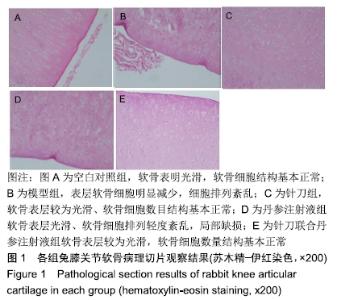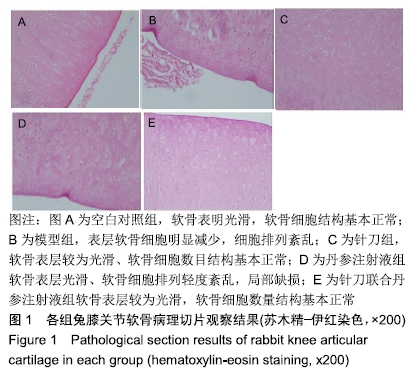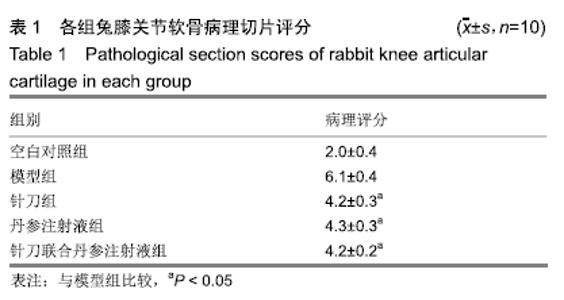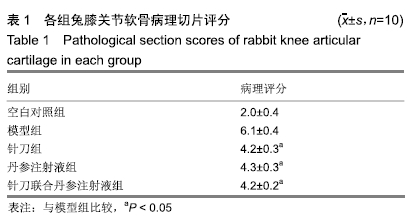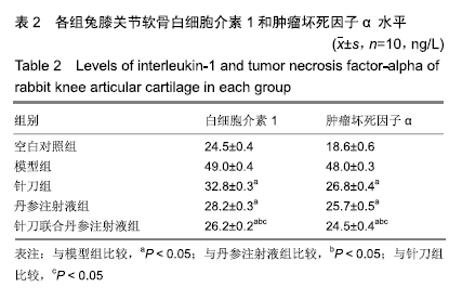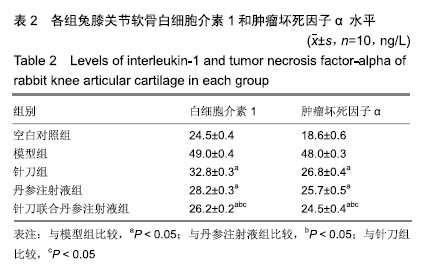[1] ZHANG Y, JORDAN JM.Epidemiology of Osteoarthritis. Clin Geriatr Med. 2010;26(3):355-369.
[2] 向珍蛹,茅建春,徐先国,等.膝骨关节炎中医证型分布的流行病学研究[J].上海中医药杂志,2012,46(12):5-8.
[3] 张旭斌,华臻,王建伟.中医外治法治疗膝骨关节炎的最新研究进展[J].针灸临床杂志,2018,34,(11)79-82.
[4] 石先明,刘延东.针刀疗法对改善膝骨关节炎症状的短期疗效观察[J].广州中医药大学学报,2019,36(1):74-78.
[5] 刘倩,张媛,李安平,等.丹参注射液有效成分的确定及不同厂家中量效关系的比较[J].药物分析杂志,2014,34(3):500-504.
[6] 王秀华,苏姿兵,田万斌.丹参注射液对兔骨关节炎软骨的影响[J].辽宁中医杂志,2003,30(10):860-861.
[7] 张子峰,熊昌源,梁克玉.骨内高压致骨性关节炎的动物实验[J].前卫医药杂志,1998,15(6)26-27.
[8] 刘福水,郭长青,张义,等.针刀与关节腔注射玻璃酸钠治疗膝骨关节炎疗效比较的系统评价和Meta分析[J].中华中医药杂志,2012, 27(4):999-1003.
[9] THOMAS E, PEAT G, CROFT P.Defining and mapping the person with osteoarthritis for population studies and public health. Rheumatology (Oxford). 2014;53(2):338-345.
[10] 张轶超.晚期膝关节骨关节炎外科治疗的取舍[J].中国骨与关节杂志,2018,7(12):881-884.
[11] 文材,尹立.人工膝关节置换术的发展概况与进展[J].中国医药指南,2018,16(31):31-34.
[12] 骆巍,马信龙,黄竞敏.高位胫骨截骨术研究进展[J].中国矫形外科杂志,2018,26(19):1786-1789.
[13] 酒涛,李彦周,李伟丰.早期膝骨性关节炎治疗方式的选择探讨[J].中国现代药物应用,2013,7(16):86-87.
[14] 崔振方.在英国开展针刀医疗的体会[J].科学之友(B版),2007(4): 248+250.
[15] 霍康富,李楠,王和鸣.膝骨关节炎动物模型的研究进展[J].中国中医骨伤科杂志,2014,22(11):68-71.
[16] SILBERBERG M, SILBERBERG R.Age changes of bones andjoints in various strains of mice.Am J Anat.1941;68(1): 69-95.
[17] SALMINEN HJ, SÄÄMÄNEN AM, VANKEMMELBEKE MN, et al. Differential expression patterns of matrix metalloproteinases and their inhibitors during development of osteoarthritis in a transgenic mouse model. Ann Rheum Dis. 2002;61(7):591-597.
[18] 郝振明,杨晓,应万涛,等.Smad3基因剔除致骨关节炎小鼠血清蛋白质组双向凝胶电泳分析[J].生物工程学报,2002,18(4): 452-456.
[19] 章权,章建华.骨关节炎软骨细胞凋亡及其调控基因的研究进展[J].浙江中西医结合杂志,2013,23(3):242-244.
[20] 韩冠英,凌沛学,王凤山,等.不同浓度木瓜蛋白酶建立兔膝骨关节炎模型的比较研究[J].中国骨伤,2012,25(5):424-429.
[21] 何名江,张洪美,荆琳,等.骨关节炎动物模型:谁最适宜你的研究?[J].中国组织工程研究,2013,17(46):8069-8074.
[22] 尚平,贺宪,陈孝银,等.过伸位和过屈位固定复制骨性关节炎动物模型的比较[J].生物骨科材料与临床研究,2006,3(1):11-14.
[23] 顾延,戴尅戎,裘世静,等.异常高应力导致关节软骨退变机理的形态学研究[J].中华外科杂志,1995,33(10):597-600.
[24] ROGART JN, BARRACH HJ, CHICHESTER CO. Chichester.Articular collagen degradation in the Hulth-Telhag model of osteoarthritis. Osteoarthritis Cartilage. 1999;7(6): 539-547.
[25] 王云峰,白人骁,张扬,等.改良Hulth模型复制膝不同时期骨关节炎的实验研究[J].天津医科大学学报,2009,15(3):400-404.
[26] 朱汉章.针刀医学基础理论体系的形成与完善[J].科学之友(B版), 2007(4):21-25.
[27] 刘福水,方婷,金德忠,等.针刀疗法疾病谱的研究[J].辽宁中医杂志,2018,45(7):1484-1487.
[28] 缪忠绿,小针刀联合股四头肌肌力训练治疗膝骨关节炎的临床观察[D].广州:广州中医药大学,2018.
[29] 胡波,于佳妮,张慧方,等.针刀干预对KOA兔关节软骨病理学及股四头肌收缩性能的影响[J].针灸临床杂志,2018,34(11): 50-54+91.
[30] 安加华,华全红,王海东.针刀松解术缓解膝关节病变患者疼痛及改善关节功能的效果研究[J].内科,2018,13(4):565-567+622.
[31] 蔡绍明,李层.膝关节镜结合小针刀治疗膝骨性关节炎的临床研究[J].湖北中医杂志,2018,40(11):38-40.
[32] 曹莉,金瑛.温针灸结合超微针刀治疗膝关节骨性关节炎46例临床观察[J].浙江中医杂志,2018,53(11):837-838.
[33] 雷志永,杨恺.高频超声对中医针刀治疗膝关节炎中的应用价值分析[J].中西医结合心血管病电子杂志,2018,6(13):165-166.
[34] 姜功道,万碧江,黄伟,等.针刀松解术对类风湿关节炎肘关节僵硬患者关节液IL-6、IL-10及TNF-α的影响(英文)[J].World Journal of Acupuncture-Moxibustion.2018,28(2):91-96+152.
[35] 王晶,胡敏霞.肌骨超声技术观察针刀治疗膝骨关节炎患者的临床效果与影像学变化[J].医学影像学杂志,2018,28(9): 1544-1547.
[36] 曹振武,黄永明,田振江,等.针刀联合局部封闭治疗膝骨关节炎临床疗效观察[J].中国中医骨伤科杂志,2018,26(8):18-20+25.
[37] 冯文昌,王庆,马碧涛,等.针刀联合消瘀散外敷治疗膝骨关节炎的临床观察[J].上海中医药杂志,2018,52(8)54-57.
[38] 韩清森.小针刀联合中药熏蒸治疗膝关节骨性关节炎临床观察[J].实用中医药杂志,2018,34(6)632-633.
[39] 黄诚,冷干生,钟杨芳,等.针刀配合中药熏洗治疗膝关节骨性关节炎的临床研究[J].蛇志,2018,30(3):456-457+497.
[40] 户红卿,冯前,王福祥,等.针刀结合隔三七饼灸治疗血瘀型膝原发性骨关节炎疗效观察[J].现代中西医结合杂志,2018,27(22): 2462-2465.
[41] 柯洪奎.氨基葡萄糖联合小针刀治疗膝关节炎临床观察[J].世界最新医学信息文摘,2018,18(97):75.
[42] 马达提•阿汉,姜磊,曹新宇.臭氧冲洗配合针刀松解治疗骨性关节炎的效果观察[J].临床医药文献电子杂志,2018,5(40):81.
[43] 刘广宇,张杰,张晓峰,等.针刀配合手法治疗对兔膝关节炎关节软骨形体结构的影响[J].环球中医药,2018,11(11):1657-1661.
[44] 胡学伏,伍新林,胡世毅,等.针刀镜微创术联合独活防萆冲剂治疗膝骨性关节炎的临床研究[J].智慧健康,2018,4(30):60-61.
[45] 刘海波,徐峻,彭勇,等.丹参活血化瘀活性成分的靶标[J].物理化学学报,2010,26(1):199-205.
[46] 徐西林,张晓峰,吕航,等.丹参注射液对骨性关节炎模型兔膝关节软骨细胞p-IκBα表达影响的实验研究[J].中国中医药科技,2017, 24(4):438-440.
[47] 佟方明,李瑞卿,李玲.丹参注射液关节冲洗并透明质酸钠治疗膝关节骨关节炎[J].黑龙江医药科学,2005,28(4):107-108.
[48] 吴旭林,温志龙,邹健泉.丹参注射液联合玻璃酸钠腔内注射治疗膝骨性关节炎[J].实用中西医结合临床,2017,17(12):124-125.
[49] 刘旭卓.丹参注射液配合丹参酮ⅡA治疗膝骨性关节炎的临床观察[D].哈尔滨:黑龙江中医药大学,2009.
|
